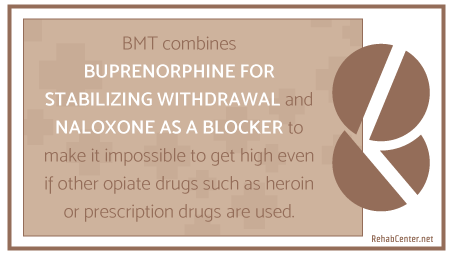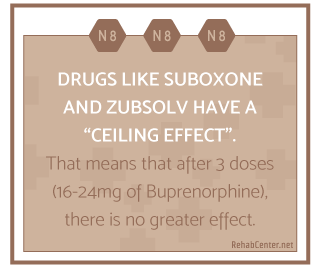Questions and Answers on Buprenorphine Maintenance Therapy for Opioid Use Disorder

When people are overusing opiates, whether prescription pills or heroin, patients deserve to be treated as the whole people that they are. One form of Medication Assisted Treatment (MAT) that is often referred to as Suboxone Therapy or more specifically Buprenorphine Maintenance Therapy (BMT) offers people just such a treatment approach. BMT combines Buprenorphine for stabilizing withdrawal and Naloxone as a blocker to make it impossible to get high even if other opiate drugs such as heroin or prescription drugs are used.

This medication, when combined with behavioral therapy, life skills and support in key areas of life, has shown to be remarkably effective as tools in the overall recovery process. There are many misconceptions, questions and myths surrounding this type of therapy for Opioid Use Disorder. This article will help address some of these questions.
Question: Isn’t this just substituting one opiate for another?
Answer: No.
A stabilizing drug and a blocker are used. However, Federal Law also REQUIRES patients who are using this treatment also receive:
- Regular Medical Supervision by a Specially Licensed Doctor
- Active, Formal, Substance Abuse Counseling
- Behavioral Therapy
- Vocational Counseling
- Education on Key Life Skills
- Other Assessment and Treatment Services as Needed
These services are to continue for the entire time that a person is in the Medication Assisted Treatment Program, but long-term maintenance can include the drug therapy alone. By long-term maintenance, we are talking about years of sustained recovery before counseling is considered to have been successful. For most patients, counseling is something that is part of the process from start to finish.
Q: Isn’t this just like Methadone?
A: No.
Methadone and Buprenorphine/Naloxone Assisted Treatment differ in many key ways:
- In MAT with Methadone, a dosage is traditionally set by the patient self-reporting their need for the drug. Therefore the process has the potential to reinforce the drug-seeking behavior of requesting greater and greater doses for the same effect. In MAT with Buprenorphine/Naloxone, the doctor is directly in control of dosing by prescription the entire time during induction, maintenance, and the wean-down process. Requests for increasing doses go directly through the doctor. Most patients do not increase their dose after they are stabilized.
- Drugs like Suboxone and Zubsolv have a “ceiling effect”. That means that after 3 doses (16-24mg of Buprenorphine), there is no greater effect. Methadone has an additional effect for patients meaning that two doses equate to twice the effect, and this makes it unique among opioid drugs. This means that a person can develop a dependence on larger and larger doses over time. Using a drug combination like Buprenorphine/Naloxone with a “ceiling effect” stops the cycle of greater and greater doses for the same effect resulting in an overall stabilizing effect for the patient.
- Methadone clinics are only available in larger cities. At these facilities, people come to the Opioid Treatment Center (OTC) and get daily doses. Daily dosing is required due to the potential for dependence or overdose with this drug if not dispensed in measured doses at a licensed OTC. With the risk of overusing minimized and the risk of overdose virtually non-existent, MAT with Buprenorphine/Naloxone is safe to prescribe for 30 days at a time. This makes it much more effective for rural areas than Methadone.

Q: Is Buprenorphine/Naloxone safe?
A: Yes.
- Buprenorphine is a “partial agonist”. This means that there is a dose at which there are no further effects on the respiratory system regardless of how much more a person takes. Other opiates have no ceiling on their effects which can lead to an increased respiratory suppression and eventual death.
- Because drugs like Suboxone and Zubsolv contain Naloxone, an opiate blocker, opioid drugs cannot bind to the receptors, because they are actually full. This means that even if a person continued to use opioid drugs they would receive no high from them.
- Groups that are most susceptible to experiencing overdose on this drug include those who have never used opiates or children. It should be noted that children or pets can also consume this drug combination when a pill is broken and creates dust-like particles that fall on the floor. Caution should always be taken when consuming any drug.

Q: Will the use of Buprenorphine/Naloxone interfere with my ability to drive or hold down a job?
A: No.
- Studies have consistently shown that people who suffer from opioid use disorders can safely operate a motor vehicle or maintain gainful employment while on this drug combination.
- The partial agonist effects of Buprenorphine do not induce a “high” in opiate-dependent patients. Instead, it stabilizes their withdrawal symptoms and keeps them from using other opiate drugs. The effects are not euphoric and have been shown not to impair driving or interfere with employment.
- Studies have consistently shown that BMT is associated with greater participation in the workforce for patients with an opiate use disorder when compared to those who are not receiving maintenance therapy.
- For those who are opioid naive, that is, have never abused opiate drugs, Buprenorphine can be a strong drug and create a “high”. This is not true for those dependent on opiates.
Q: Is Buprenorphine/Naloxone treatment and counseling effective?
A: Yes.
While the ultimate goal of BMT should be a complete recovery from using opiate drugs, there are several key things that BMT has been shown to do:
- Improve patient survival
- Increase retention in treatment
- Decrease illicit opiate use and other criminal activity among people with opioid use disorders
- Increase patients’ ability to gain and maintain employment
- Improve birth outcomes among women who have opioid use disorders and are pregnant
Q: Can pregnant women who are opiate dependent use Buprenorphine/Naloxone?
A: No.
- Naloxone has not been tested in pregnant women. Therefore, the safety of Naloxone is not known for pregnant women.
- When an opioid-dependent woman becomes pregnant, current protocol is to have the patient take Buprenorphine by itself since the safety of Naloxone in pregnancy is not established. This drug is called Subutex. It contains Buprenorphine only and has been demonstrated that it can be safely taken by the mother during pregnancy. Mothers are typically switched back to Buprenorphine/Naloxone around 6-8 weeks after giving birth.
- Studies have shown that infants born to mothers on Buprenorphine have relatively low rates of newborn withdrawal symptoms compared to those who continue to use heroin or prescription opioids.

Q: Are people on this therapy for the rest of their lives?
A: No.
In many cases, Buprenorphine therapy will take from 1-5 years. Research suggests that MAT should last for an undetermined amount of time, and the wean-down process should be decided by a team made up of the doctor, the therapist, and the patient themselves.
Q: Will people know that I am on Buprenorphine/Naloxone? Am I required to tell employers that I am on it?
A: No.
- All patients who take part in substance use treatment like MAT are covered by the highest level of privacy afforded in medicine.
- No communication with anyone outside of the medical or counselor’s office is allowed without a formal release signed by the patient. Only in situations where there is an immediate threat of harm to or from the patient can communication occur without this release being signed. This is known as a “duty to report” and it is rare.
- Federal law requires a 42 CFR release of information form for any communication to occur outside of the OTC or medical center where the physician is practicing
- You are not required to inform an employer or potential employer that you are on BMT.
- Most pre-employment drug testing will not test for these drugs.
Q: Can I use Buprenorphine/Naloxone on probation?
A: It depends entirely on the policies in your state or county.
- Some probation officers will allow BMT without any questions, while others will not in any case. It typically depends on either the opinion of the individual officer, the judge presiding over the case or the county or state. Many Drug Courts still prohibit MAT.
- The National Institutes of Health recommends the prisons accommodate MAT, but inconsistency is still the norm.
- If a patient is told by their probation officer that they cannot use BMT, it is often helpful if your doctor or a nurse, social worker or counselor advocates for you to remain in the treatment while you are on probation.
Q: Can I use Buprenorphine/Naloxone while I am in residential treatment?
A: Yes, if the facility agrees to dispense the medication to you.
- Some residential treatment facilities will allow you to take your BMT while you are there.
- Some residential programs will, under the suggestion of a counselor, refer patients to local OTC’s in order to begin the therapy. Typically, these referrals occur only after the agency has established a relationship with the OTC for such referrals. If one is not available in the area you are returning to after your residential treatment, then it may not be appropriate to begin the BMT until you can find an OTC near where you will be living.
- Because of the long-term nature of BMT, most residential programs will not have an on-staff doctor prescribe BMT. Since most residential programs are anywhere from 14 days 90 days, they do not have the long-term capability to continue to provide the required services to prescribe BMT themselves over the undetermined amount of time it would take for this therapy to become fully effective. Prescribing BMT for the short-term periods of a residential treatment could be considered an ethical breach in patient care if the patient was not guaranteed a place in an OTC once they left the facility.
- If a residential facility does not specifically counsel patients regarding BMT, it may be necessary for them to transport you to regular, weekly counseling outside of the residential program so that you can also get counseling related directly to BMT and interact with others in group settings who are also on the therapy.
- If a referral is made to an OTC, the OTC should have the patient sign a 42 CFR release in order to coordinate care between the doctor’s office and the residential program/counselor for the time that the patient is in the facility.

Summary:
Buprenorphine Maintenance Therapy can be an effective approach to treating chronic opioid use disorders. There are many misconceptions regarding this relatively new approach to treating opioid dependence, but the research suggests that this can be a lifesaving therapy when combined with substance use counseling, vocational and other assessment and treatments.
If you or a loved one are looking for treatment with BMT, you can locate doctors and OTC’s by searching: Buprenorphine Treatment Physician Locator
Written by Adam C. DeVaney, LLMSW
Additional Resources From RehabCenter.net:
- Walking Through the Buprenorphine Treatment Process
- Buprenorphine: Suboxone And Subutex For Opiate Addiction Treatment
- Does Insurance Cover The Cost Of Suboxone?
- Treating Opiate Addiction During Pregnancy
- Zubsolv: A New Medication To Combat The Prescription Opiate
DrugAbuse.gov - Long-Term Follow-Up of Medication-Assisted Treatment for Addiction to Pain Relievers Yields “Cause for Optimism”
Journal of Substance Abuse Treatment - The Multi-Site Prescription Opioid Addiction Treatment Study: 18-Month Outcomes
SAMHSA.gov - Applying the Substance Abuse Confidentiality Regulations
MedScape.com - Buprenorphine/Naloxone Toxicity




